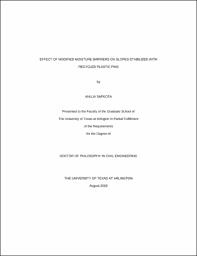| dc.description.abstract | High plasticity expansive clayey soils are prone to repeated swelling and shrinkage due to cyclic climatic variations. These variations lead to desiccation cracks that act as pathways for rainfall intrusion into the slope, and lead to increased moisture content. The increase in the moisture content of the soil generates considerable hydrostatic pressure, which can cause pavement distress and shallow slope failure. Previously, failed slopes in North Texas were repaired by the UTA research team using only recycled plastic pins, which increase the stability of the slope but do not improve the performance of the pavement shoulder or limit the intrusion of moisture into the slope. Since these types of distresses and failures are frequently observed in many parts of North Texas, an approach for minimizing the rainfall intrusion into the desiccation cracks and increasing the lateral stability of the slope was developed, combining the use of modified moisture barriers and recycled plastic pins. The developed method was applied to stabilize a failed slope along US Highway 287 located near Midlothian, Texas. The failed highway segment was divided into three test sections: a pin-plus barrier section, pin-only section, and control section. The pin-plus barrier section was stabilized with both a modified moisture barrier and recycled plastic pins, the pin-only section was stabilized using only the recycled plastic pins, and the control section was left unstabilized. The stabilized and unstabilized sections were instrumented with integrated temperature and moisture sensors, rain gauges, and inclinometers to monitor real-time moisture and temperature variations, rainfall events, and lateral deformation of slopes, respectively. A topographic survey was conducted to monitor the vertical settlement and edge drops of stabilized and unstabilized slopes, and resistivity imaging was performed on a monthly basis to monitor the continuous subsurface profile and to determine the depth of active moisture fluctuations. The sections were monitored periodically to evaluate the effectiveness of the proposed stabilization method as compared to other sections.
Measuring the volumetric moisture content in the control and pin-only sections revealed an instantaneous response to rainfall events, while measuring the volumetric water content measured in the pin-plus barrier section showed insignificant variations, even with the rainfall events. The maximum moisture variation of the control and pin-only sections was 32.81%, while the maximum moisture variation of the pin-plus barrier was 3.89%. Therefore, it can be concluded that the use of a modified moisture barrier significantly reduced moisture intrusion into the slope. The variations in the moisture content directly reflected the measured lateral movement and vertical settlement of the slopes. Maximum lateral movements of 1.5 inches and 0.8 inches were observed in the control section and pin-only section, respectively, while only 0.38 inches lateral movement was observed in the pin-plus barrier section. The average vertical settlements observed in the control and pin-only sections were 2.65 inches and 1.61 inches, respectively, while only 0.59 inches vertical settlement was observed in the pin-plus barrier section. The performances of the test sections were evaluated using the finite element program PLAXIS 2D, and the results of the finite element model were in good agreement with the field performance results. The numerical study also showed an improvement in the stability of the slope with an increase in the length of the modified moisture barrier along the slope. In summary, the combined use of modified moisture barriers and recycled plastic pins is effective in increasing the stability of highway slopes by limiting the rainfall-induced moisture variations, lateral deformation, and vertical settlement. | |


